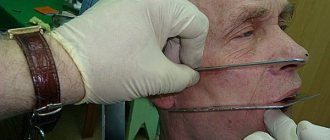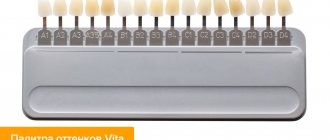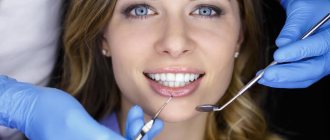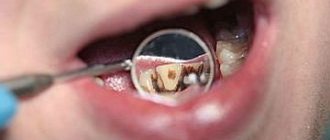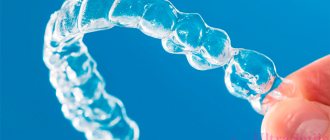Our enamel is constantly exposed to aggressive external factors, such as coloring products, coffee and tea, medications, and tobacco smoke. All this over time leads to a gradual change in the color of the teeth, the formation of abundant yellow plaque, which over time turns into hardened deposits that provoke the development of caries. Today, the Vita tooth color scale is actively used in dentistry - it is used to determine the shade of enamel, predict the results of whitening, and select the appropriate tone for filling materials. Later in this article we will talk about what this scale is, when it is used and how to use it correctly.
What color is considered normal for a milk bite?
Baby or primary teeth in children are usually whiter than permanent teeth in adults. This color comes from thinner enamel than permanent crowns. If the milk crowns have a yellowish or grayish tint, then this indicates their disease or a metabolic disorder in the body.
The method of returning the natural shade to temporary units depends on the reasons for its change. Sometimes it is enough to exclude certain foods from the diet and start filtering the water, and the color of the crowns will gradually be restored. If the change in enamel color is caused by a disease, then it is important to establish a diagnosis and select adequate treatment.
Reasons for changes in enamel color in children
- Some diseases of a pregnant woman: viral or bacterial infections of the mother’s body, as well as some medications (for example, tetracycline antibiotics) leave an imprint on the development of the fetus, including the formation of its tooth buds. This is fraught with the fact that the baby will erupt in units already with a defect (enamel hypoplasia or hyperplasia, tetracycline teeth, etc.),
- initial stage of caries: may change the color of milk crowns (white spots appear on them),
- fluorosis: a surplus of fluoride in a child’s body (due to the large consumption of fluoride-containing products, water, the use of toothpaste with a high content of this element) changes the color of the enamel, it becomes grayer and at the same time rough, brittle, with grooves,
- treatment with iron preparations: if they are used in liquid form, they cause temporary darkening of the tooth surface,
- constant consumption of coloring products: blueberries, bird cherry, sweets and drinks with artificial colors or based on red and blue berries.
Optimal enamel color and reasons for its change
It is a mistake to assume that only white teeth are a sure sign of good health. Moreover, even enamel that has turned yellow over time should not be taken as a serious cause for concern, remembering that, in addition to dental problems, such changes are provoked by many other factors.
According to research data, 97 percent of enamel has nothing to do with organic compounds, which means that it will be extremely difficult to choose an identical shade of teeth for two different people, it’s all so individual.
Why does the whiteness of teeth depend and what factors tend to influence its change? The most common of them are:
- hereditary predisposition and tendency to all kinds of dental diseases;
- failure to comply with personal hygiene rules or improper brushing of teeth;
- eating foods and drinks that contain various groups of dyes (berries, coffee, soy sauce, etc.);
- smoking;
- age-related changes with which dentin begins to darken, acquiring a red-brown tone;
- degree of strength of dental bone tissue;
- excess or deficiency of certain vitamins in the body;
- the thickness of the enamel layer through which dentin, which is naturally yellow in color, can be visible;
- microrelief of teeth, the severity of which determines whiteness.
In order to preserve pristine whiteness, a person will have to apply maximum effort to this from childhood, which is not always convenient. And it’s not a fact that they will give an effective result, because it’s not without reason that only a few can boast of the ideal color of their teeth, most often owing their beauty to nature.
It is difficult to single out the most popular shade, because the enamel color of each person is unique. The scale only helps you choose the most suitable color. One thing is for sure - now natural color is in fashion, not perfectly snow-white
Reasons for changes in tooth shade in adults
- violation of the rules of brushing teeth at home: irregularity, unsuitable toothpaste or brush,
- hereditary reasons
- the richness of the daily menu with pigmented products: black berries, strong black and red tea, coffee without milk, red wine, ketchup, soy sauce, etc.,
- smoking: gives a yellow or even gray-yellow coating,
- With age, dentin darkens and enamel becomes thinner: therefore, crowns acquire a darker shade than in youth - due to translucent dentin. Thinning of the enamel due to metabolic disorders also leads to a change in the color of the unit, because dentin is naturally yellow,
- deficiency or surplus of certain vitamins or microelements: zinc, fluorine, iron in the body,
- the presence of an old filling: often its elements penetrate into the dentin over time, oxidize and color it gray or red, which affects the external shade,
- microrelief of the crown surface: the more pronounced it is (grooves, pits, roughness), the darker the crowns appear.
Attention! After professional teeth cleaning (without bleaching), crowns may become a shade or even two lighter. This happens because the hygienist removes plaque, which gives a darker color, grinds and polishes the teeth, leveling the microrelief.
Methods for restoring natural shades of enamel
If there has been a change in the normal color of the teeth (that is, they have become pigmented), in most cases it is possible to restore their natural shade. First of all, you will need to find out the reasons for the color change, the appearance of stripes or spots. After diagnosis, the factors that caused the change in the natural color of the teeth are eliminated. Sometimes this is enough to return natural whiteness, but in some cases additional procedures are required. Basic methods:
- professional teeth cleaning and removal of deposits from their surface - if the change in shade is caused by accumulations of stone and plaque, it is enough to get rid of them so that the color of natural teeth changes and they become several shades lighter;
- whitening (external or intracanal) - often carried out using formulations based on hydrogen peroxide; if traumatic periodontitis has caused the discoloration of teeth, then the shade can be restored in just one visit to the dentist, in all other cases a course of procedures will be required;
- orthopedic methods - installation of ceramic crowns or microprosthetics with veneers are indicated when the color of teeth changes due to taking tetracycline medications, if the enamel has low resistance, and also if pigmentation is caused by artificial materials in the tooth.
Scope of application of the Vita scale
Using a basic color chart, the dentist can identify the “native” shade of a person’s teeth or detect, if any, possible color defects. The fact is that the same tooth color looks different in people with different skin colors. For example, an unpleasant yellow tint is masked if a person returns from vacation very tanned, and then his smile appears white. However, the Vita scale helps to adequately assess the clinical picture. Such a tool is important in several dental fields.
The Vita scale is often used in the following situations:
- professional teeth cleaning with ultrasound and Air-flow: after ridding the patient of plaque, the hygienist must make sure that he has restored the natural color of the crowns. In addition, the Vita scale can be used before the procedure to conduct a comparative analysis of the effect of tartar on the color of crowns and to develop an individual oral care program for a particular person (this may include both nutritional correction and the cessation of bad habits, the use of certain brands of dental pastes and even brushes),
- for whitening in the clinic: laser, intracanal, photo bleaching, chemical bleaching. The doctor needs the palette to determine how many shades the enamel needs to be whitened, whether the result will look unnatural and whether it will lead to negative consequences, especially if the patient wants a snow-white smile, but the condition of his crowns does not allow him to achieve such a shade. In addition, during the procedure, the doctor should check the result so as not to overdo it,
- dental restoration: in the presence of chips, cracks and other surface defects, it is important that the filling, crown or microprosthesis are not noticeable on natural dental tissues.
How is the Vita scale used?
All the previously mentioned reasons must be taken into account by the dentist when a patient comes to him who needs treatment or cosmetic restoration of crowns. In all these cases, the doctor must focus on the natural appearance of the enamel in order to select the filling material of the desired shade or install veneers. For this, doctors use the Vita scale.
It is represented by a kind of palette, divided into quarters (sectors), designated by indices A, B, C and D. Each sector has several subtones, and thus the doctor has the ability to operate with 16 shades. This allows you to correctly correct the color during treatment or prosthetics. In addition, the patient himself can compare and choose the shade that seems most natural and acceptable to him.
Interesting! The Vita scale is usually made of laminated cardboard, plastic or thick paper, but professionals use a movable table with painted acrylic or ceramic overlays. This device is convenient to apply to the teeth, comparing and adjusting shades. The basic table produced by Ivoclar Vivadent (Liechtenstein) has good reviews from doctors all over the world. Its slats include the lightest shades (Bleach) of groups A, B, C and D. This palette costs 1,400 rubles.
In modern dentistry, all possible shades of enamel are usually divided into 4 groups:
- group A: reddish with a brownish bias, includes the five most popular shades - A1, A2, A3, A3.5 and A4,
- group B: red with a yellow bias. Includes 4 semitones from B1 to B4,
- group C: gray shades. This also includes 4 semitones - from C1 to C4,
- group D: red with a gray bias. Less common in our country, it has only three subtones - from D2 to D4, and D1 is absent altogether.
“The Vita scale is easy to use. Reusable, easy to apply due to the fact that it is laminated. I recommend purchasing this product for those who whiten their teeth at home. It will last a very long time."
Nastya, review from otzovik.com
Review of modern technologies for determining the color of a patient’s teeth in a dental clinic
Tags: Color selection
Recently, scientists have developed a fairly large number of theories for determining the color of teeth. Each of them reflects a number of environmental, temporal and physiological factors that influence the mechanism of visual perception of a dentist.
The following factors are of great importance in determining the color of teeth:
- Light source;
- Light level of the tooth;
- Reflected light-reflex;
- Color adaptation;
- Interpretation of color.
Even if all people had the same retinal structure, color perception would remain subjective due to differences in color perception abilities. The most important condition for achieving success is close cooperation between the dentist and the patient. With the help of modern technologies, it is possible to obtain useful additional information, for example, to determine the color of the patient’s teeth not only visually, but also using digital technology. Visual technologies for determining tooth color are a subjective process and require certain knowledge and skills, optimal conditions, and also depend on individual characteristics, such as color perception and visual acuity.
COLOR VITA CLASSICAL (VITA ZAHNFABRIK)
VITA coloring has 16 colors, divided into four tone ranges: A, B, C, D ( Fig. 1 ):
- A – orange-brown;
- B – yellow-orange;
- C – gray-brown;
- D – orange-gray.
Rice. 1
In real life, one of the colors may predominate over the others, for example, A3 with a predominance of orange, or A3.5 - more saturated, but not A4. The neck of a natural tooth, as a rule, is colored more intensely because it is the thinnest layer of enamel, which must be taken into account when determining the color. Sometimes the color of the neck of the tooth may be in a tone different from the main one. For example, the main tone may be A, but the neck of the tooth may be yellow with a range of B. For the aesthetic appearance of the restoration, the brightness indicator plays the most important role. The VITA coloring comes with an insert where the colors are arranged according to brightness: B1, A1, B2, D2, A2, C1, C2, D4, A3, D3, B3, A3.5, B4, C3, A4, C4. You can often see teeth that have a tone A or B, but at the same time, their brightness is quite similar to the C range. That is, if you apply one of the teeth of color group C to such a tooth with reduced brightness, you will see that it (the tooth from the color) will hardly stand out. The teeth will be identical in brightness, and the only difference will be in color. An error in brightness instantly highlights the restoration in the oral cavity. A difference in color or saturation is sometimes not as noticeable as an error in brightness.
COLOR VITA SYSTEM 3D-MASTER (VITA ZAHNFABRIK)
The VITA SYSTEM 3D-MASTER color system developed by the company’s specialists is based on the principles of colorimetry (lightness, saturation and hue) and consists of 26 colors. It managed to systematize all possible shades of the color of a living tooth and arrange them into a scale that is simple and convenient for doctors and technicians to use ( Fig. 2–3 ). Although the perception of colors is always subjective, colors are nevertheless, from a physical point of view, distributed along the spectrum in a three-dimensional spherical model based on three basic characteristics of color.
Rice. 2
Rice. 3
- Determination of lightness (L – Lightness)
All teeth standards on the scale are divided into five lightness groups. In each individual group, the standards differ in color saturation and hue, but have the same lightness parameter. At the first stage, only lightness is determined, i.e. you need to choose not one of 26 standards, but determine one of five groups by lightness.
- Determination of saturation (C – Chroma)
In the previously selected lightness group, the middle bar is taken and fanned out. All standards on the bar are of the same shade and lightness. Of these, you need to choose one that is most suitable in terms of saturation.
- Determination of hue (H – Hue)
The need for this stage will arise if the patient’s tooth still differs from the selected standard towards a yellowish or reddish tint. Then you need to select one of the standards with the designation L (yellowish) or with R (reddish) all in the same lightness group and clarify the color coding: instead of the designation M there will be L or R. This completes the choice of color.
CHROMASCOP COLOR (IVOCLAR VIVADENT)
The Chromascop shade is a practical, universal shade. It consists of 20 colors, which are divided into 5 visual, removable color groups ( Fig. 4) :
- 110–140 – white
- 210–240 – yellow
- 310–340 – light brown
- 410–440 – gray
- 510–540 – dark brown
Rice. 4
After determining the main shade, further color determination operations are carried out only within the corresponding group. Consistent rejection of unnecessary effects when designing the Chromascop shade (for example, the image of the neck, transparent areas, strong color changes in the area of the incisal edge and dentin, as well as surface coloring) makes it much easier to determine the shade of the tooth. The main advantage of this color is its wide range of applications. Unfortunately, determining the color of teeth using a standard shade scale (visual technologies) does not always give a real picture, because teeth, like any other creation of nature, are very multicolored (multichrome). Digital technologies for determining the color of natural teeth, unlike visual technologies, do not depend on the subjective opinion of the doctor and the color shades of the environment. The essence of these technologies is an objective computer analysis of the image obtained under ideal optical conditions, then based on it, a high-quality map of tooth shades is compiled, indicating transparency.
SPECTROMETER SHADEPILOT (DEGUDENT)
The Shadepilot spectrometer from DeguDent provides an opportunity to significantly improve the accuracy of color determination, the objectivity of the information received, and eliminate the influence of subjective factors on the results of work. According to DeguDent specialists, in the future color determination will become exclusively digital. Shadepilot combines various digital capabilities: high-quality image production and digital processing, a wide variety of additional options, ease of use. With its help, you can evaluate all the basic color parameters: shades, brightness, saturation and transparency. Allows you to accurately analyze the spectral composition of color. The analysis results do not depend on the type of lighting fixtures installed in the room or other lighting conditions.
SHADESCAN DEVICE (CYNOVAD)
The ShadeScan device from CYNOVAD allows you to obtain a full range of information about tooth color. The operating principle is based on color analysis of digital photographs. The device allows you to evaluate all the most important parameters of tooth color: shades (according to various palettes), intensity, brightness and transparency, as well as its shape. The measurement technique is based on the principle of artificial vision, which, according to the manufacturer, is as close as possible to the mechanism of human color perception. Thanks to the integrated light source, measurement results are independent of external lighting conditions, which significantly increases their objectivity. In principle, the use of this device allows the correct selection of shades to be made without direct contact between the patient and the dental technician. In addition, the ability to store data on a flash card greatly facilitates the exchange of information between the clinic and the dental laboratory.
SHADEEYENCC DEVICE (SHOFUDENTAL)
The ShadeEyeNCC device from ShofuDental determines the exact composition of the color and adapts the results to the palettes of 5 standard color systems. The built-in memory is designed to store up to 100 measurement protocols, so this device can be used as a mobile measuring center. Using an infrared port, the results obtained are easily transferred to a PC, from which they can be saved to any storage medium and sent by e-mail. The software complements and expands the native capabilities of the measuring device. With its help, you can create a three-dimensional color picture of a natural tooth, consisting of 256 shades.
VITA EASYSHADE (VITA ZAHNFABRIK)
The VITA Easyshade is a spectrophotometer for intraoral use and shade determination according to the VITA Classical and VITA 3D-Master systems, and is therefore ideal for shade selection of restorations made from the wide range of VITA ceramic materials. The working part contains a special fiber-optic probe for lighting and recording the color of teeth, several spectrometers and one microprocessor for communication with the electronic unit ( Fig. 5 ).
Rice. 5
DEVICE (SMILE LINE)
Inspired by the work of renowned lecturers and clinicians, including L. Vanini (1996) and S. Papazoglou (2016), together with the Styleitaliano team (a group of passionate researchers and clinicians - www.styleitaliano.org), Smile Line has released a special polarizing filter that neutralizes the surrounding artificial and natural lighting (Fig. 6) .
Rice. 6
Also, due to the neutralization of light, the shine partially disappears from the surface of the teeth, and the process of determining color is greatly simplified. The light temperature of the device is 5500°K, which corresponds to natural daylight. In addition to the SMILE LITE device, Smile Line offers its new revolutionary Smile Line MDP device, which allows you to take excellent professional dental photographs directly from your smartphone. Smile Lite MDP, which can be called a “mini photo studio,” has undergone three years of development and testing (Fig. 7–8) .
Rice. 7
Rice. 8
The device is equipped with three groups of LEDs. Each of these groups produces its own individual lighting, and you have the ability to adjust the lighting power using a dimmer switch (four different power levels are provided). The back cover of Smile Lite MDP is equipped with a universal adapter that is compatible with any smartphone with a width of 55–58 mm. Determining color in modern dentistry is an important task, the solution of which is aimed at restoring the aesthetic appearance of the entire oral cavity, improving the appearance of the patient, and, in addition, may contribute to improving overall health by gaining a sense of self-confidence. Determining color is a rather labor-intensive and complex process that requires professionalism from the dentist and careful adherence to the rules for determining color in order to eliminate inaccuracies as much as possible. However, the automated method cannot replace traditional methods. Digital technologies for determining the color of natural teeth should be a mandatory element in addition to visual assessment.
SOURCE: Digital Dentistry Magazine
Similar articles:
Akulovich Andrey
Correlation between determination of tooth color by shading and spectrophotometer
Cancellation
Correct determination of tooth color is an integral part of the development of harmony and success in aesthetic dentistry, but at the same time it is a serious problem today.
Akulovich Andrey Read
Gregory Camaleonte
Elimination of white spots using deep infiltration technique
Cancellation
Practitioners today are faced with increasing aesthetic demands from patients and must meet these needs with simple, reproducible, and whenever possible conservative treatment protocols.
Gregory Camaleonte Read
Anna Salat
Initial caries: minimally invasive treatment
Cancellation
Dentists should choose the most appropriate treatment for patients with early caries on the proximal surfaces of the chewing teeth.
Anna Salat Read
Dr. Alessandro Martini
“Unbleached” discolors. Myths and reality
Cancellation
Treatment of discolorations caused by taking tetracycline drugs is one of the biggest problems for a dentist who deals with aesthetics.
Dr. Alessandro Martini Read
Marina Papachroni
An ultra-conservative approach to the treatment of post-orthodontic white spots using the infiltration technique
Cancellation
Although treatment with fixed appliances has become an integral part of modern orthodontics, it is also associated with certain side effects.
Marina Papachroni Read
David Alleman, Matthew Nejad, David Alleman
Restorative Dentistry Protocols to Achieve Biomimetics
Cancellation
Over the past 15 years, the approach to performing restorations has steadily changed and improved, moving from mechanical to adhesive bonding principles.
David Alleman, Matthew Nejad, David Alleman Read
Leon Hermanides
Adaptation of restorations in parafunctional conditions
Cancellation
Even taking into account the fact that doctors are trying as accurately as possible to determine the prognosis of the results of future treatment, some risks or complications cannot be predicted in any way, and they have to be dealt with already at the rehabilitation stage.
Leon Hermanides Read
Caroline Werkhoven
Invisible fracture line after fixation of a tooth fragment
Cancellation
In cases of trauma where the patient is fortunate enough to retain a broken tooth fragment, a serious controversy arises.
Caroline Werkhoven Read
Maciej Zarow
Restoration of a severe tooth fracture: a clinical case with a 13-year follow-up
Cancel
It was midnight, everything was so quiet and calm, the stars were twinkling in the blue sky, and no worries of everyday life could disturb this magical moment... or at least that's what I thought.
Maciej Zarow Read
Paulo Monteiro
Step-by-step sanding and polishing protocol - Part 1
Cancel
We often discuss the problems and difficulties of restoring teeth and choosing shades for direct composite restorations. However, the shape and texture of the restoration play an important role, as does the choice of shade.
Paulo Monteiro Read
Jordi Manauta, Gaetano Paolone, Louis Hardan
Controlled Material Thickness (CBT Technique), Part II
Cancel
Correct application of enamel and dentin is one of the most important components of aesthetic stratification, which allows determining the need for the use of additional materials.
Jordi Manauta, Gaetano Paolone, Louis Hardan Read
Rim Burgi
Documenting the whitening process with Mobile Dental Photography
Cancel
The purpose of this article is to demonstrate the value of Mobile Dental Photography for dental practitioners.
Rim Bourgi Read
- ‹
- 1
- …
Tone selection features
To accurately determine which shade of the crown will be as close as possible to the natural color of the patient’s teeth, the doctor conducts a test using the Vita scale (see the visual photo below). According to the Vita determination rules, the dentist first selects which of the 4 groups the patient’s enamel color belongs to, and then within this group begins to select shades that most closely match the color of neighboring units.
How tone is assigned
The Vita subtone number is assigned based on the decrease in whiteness: the higher the number (or index), the darker the enamel color will be. For example, an overlay from the palette marked as A1 is the “whitest”, and A4 is the darkest of group A. And this rule applies to all groups.
2. Why high technology doesn’t always help
You can often read negative comments on forums that computer technology is not used to determine tone. And although there are programs developed specifically for such a procedure, the most accurate is still a visual comparison of the patient’s crowns with the base table.
Interesting to know! An adequate assessment of color by a computer is influenced by many factors: the lighting in which the image loaded into the program was taken, the resolution and color sensitivity of the camera used to take the image, and the color calibration of the computer itself. And even if at some point there was a failure of a tenth of a percent, this may affect the final result, and the sample selected by the computer will turn out to be lighter or darker than necessary.
In addition, using programs to determine the color of crowns is more expensive than using the basic Vita table, which is why doctors most often resort to this method, especially in small dental offices. And it’s more convenient for patients to compare samples in person.
3. What conditions are necessary for high-quality diagnostics
Despite the fact that using the Vita scale is cheaper and gives more accurate results, it is important to observe certain conditions when testing:
- Before testing, you need to brush your teeth twice: once at home, immediately before the appointment, and the second time the doctor cleans it using special solutions. This is necessary in order to remove microplaque that forms daily on the enamel and can affect its color,
- It is recommended that the patient come to the appointment wearing clothes in neutral pastel colors and with an open neck so that the fabric does not contrast with the face and teeth. If a person wears white, black or other bright clothing, this may distort the doctor's perception,
- In the dentist’s office, it is important to create high-quality lighting: if testing takes place in the dark, dentists use powerful lamps or special frames with LEDs to simulate daylight, which are held by the doctor’s assistant or the patient himself during testing. For the accuracy of the procedure, it is important to fully illuminate all crowns,
- the patient must be healthy: the choice of color tone according to the Vita scale, as a rule, is carried out only on healthy units of the dentition and in the absence of any chronic acute diseases in the patient. This is done because any serious disease of organs and systems can affect the natural color of crowns,
- if the patient has teeth with different shades of enamel: here the doctor often recommends an intermediate shade or a decision is made to correct not just one tooth, but the entire smile area.
What factors determine the natural color of enamel?
Before moving on to the technique of using the Vita scale in dentistry, let’s consider what the natural shade of teeth depends on and what affects their color. Several factors play a decisive role in this issue, and here are the main ones:
- heredity,
- predisposition to certain systemic pathologies,
- level of hygiene,
- diet,
- condition and strength of bone tissue.
If we talk about what tone of teeth is considered normal, then we must immediately make a reservation that the enamel consists of approximately 97% of inorganic compounds. Therefore, its natural color is different for everyone, despite the fact that a person may not have any pronounced dental problems.
Heredity primarily determines the color of teeth
A change in the color of the enamel, its yellowing should be a good reason for concern and contact a specialist. After all, poor hygiene and plaque are not the only reasons for visible changes, and the real problem may lie much deeper. The reason may be not only dental disease, but also systemic pathologies.
How to maintain results for a long time
After dentures or whitening, it is very important to keep the color of your smile natural. To do this, it is important to follow the recommendations for caring for dentures (if artificial crowns or veneers were installed) or directly for the teeth (after the whitening procedure).
As a rule, the main stages of care are daily oral hygiene, exclusion from food (at least for the first weeks) of coloring foods - berries, wine, strong tea or coffee, as well as quitting smoking.
Good to know! Bleached enamel becomes thinner, and therefore more sensitive, so to care for it you need special gentle pastes and brushes with soft bristles. Doctors also advise rinsing your mouth after every meal and using floss for high-quality cleansing.
The same goes for veneers and ceramic inlays. For example, it is not recommended to use electric ultrasonic toothbrushes if you have such microprostheses, since the high frequency of rotation or vibration of the brush head can heat the prosthesis or peel off the adhesive, which leads to deformation of the prosthesis or a reduction in service life.
Do not forget to visit the dentist once every six months so that he can monitor the condition of the oral cavity and dentures, adjust hygiene procedures, and also diagnose the presence of diseases, in particular caries, in a timely manner.
For what reasons can the shade of teeth change?
A naturally perfect snow-white smile is quite rare. In addition to the fact that most people’s teeth have a slight yellowish tint from birth, throughout their lives they are constantly exposed to external factors that cause their color to change. Here are just the main prerequisites:
- improper and irregular cleaning,
- addiction to coffee, strong tea and other coloring drinks,
- smoking cigarettes,
- aging of the body,
- dental diseases,
- consumption of products with intense coloring pigments,
- lack of vitamins and microelements or their excess in the body,
- taking certain medications.
Constant exposure to external factors causes changes in the color of teeth
. To maintain the natural whiteness of a smile, you need to follow the rules of oral hygiene, respond in time to any suspicious changes, and regularly visit the dentist’s office for preventive examinations.

